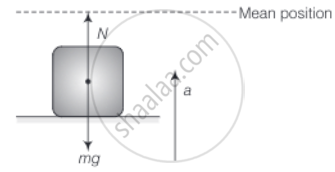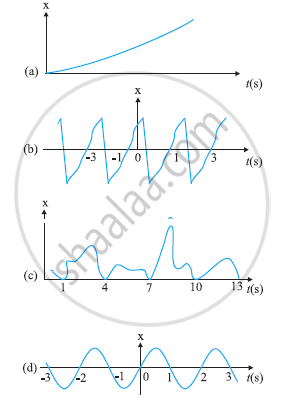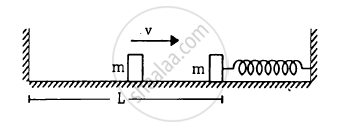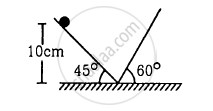Advertisements
Advertisements
प्रश्न
A person normally weighing 50 kg stands on a massless platform which oscillates up and down harmonically at a frequency of 2.0 s–1 and an amplitude 5.0 cm. A weighing machine on the platform gives the persons weight against time.
- Will there be any change in weight of the body, during the oscillation?
- If answer to part (a) is yes, what will be the maximum and minimum reading in the machine and at which position?
उत्तर
In this case, acceleration is variable. In accelerated motion, the weight of body depends on the magnitude and direction of acceleration for upward or downward motion.

a. Hence, the weight of the body changes during oscillations
b. Considering the situation in two extreme positions. as their acceleration is maximum in magnitude.
We have, mg – N = ma
∵ At the highest point, the platform is accelerating downward.
⇒ N = mg – ma
But a = ω2A .....[In magnitude]
∴ N = mg – mω2A
Where, A = amplitude of motion
Given, m = 50 kg, frequency v = 2 s–1
∴ ω = 2πv = 4π rad/s
A = 5 cm = 5 × 10–2 m
∴ N = 50 × 9.8 – 50 × (4π)2 × 5×10–2
= 50[9.8 – 16π2 × 5 × 10–2]
= 50[9.8 – 7.89]
= 50 × 1.91
= 95.5 N
When the platform is at the lowest position of its oscillation,

It is accelerating towards the mean position that is vertically upwards.
Writing the equation of motion
N – mg = ma = mω2A
or N = mg + mω2A
= m[g + ω2A]
Putting the data N = 50[9.8 + (4π)2 × 5 × 10–2]
= 50[9.8 + (12.56)2 × 5 × 10–2]
= 50[9.8 + 7.88]
= 50 × 17.68
= 884 N
Now, the machine reads the normal reaction. It is clear that
Maximum weight = 884 N ......(At lowest point)
Minimum weight = 955 N .....(At top point)
APPEARS IN
संबंधित प्रश्न
Figure depicts four x-t plots for linear motion of a particle. Which of the plots represent periodic motion? What is the period of motion (in case of periodic motion)?

A person goes to bed at sharp 10.00 pm every day. Is it an example of periodic motion? If yes, what is the time period? If no, why?
A particle executes simple harmonic motion under the restoring force provided by a spring. The time period is T. If the spring is divided in two equal parts and one part is used to continue the simple harmonic motion, the time period will
The left block in figure moves at a speed v towards the right block placed in equilibrium. All collisions to take place are elastic and the surfaces are frictionless. Show that the motions of the two blocks are periodic. Find the time period of these periodic motions. Neglect the widths of the blocks.

Find the time period of the motion of the particle shown in figure . Neglect the small effect of the bend near the bottom.

A uniform plate of mass M stays horizontally and symmetrically on two wheels rotating in opposite direction in Figure . The separation between the wheels is L. The friction coefficient between each wheel and the plate is μ. Find the time period of oscillation of the plate if it is slightly displaced along its length and released.

The period of oscillation of a body of mass m1 suspended from a light spring is T. When a body of mass m2 is tied to the first body and the system is made to oscillate, the period is 2T. Compare the masses m1 and m2
Which of the following example represent periodic motion?
A hydrogen molecule rotating about its center of mass.
When two displacements represented by y1 = a sin(ωt) and y2 = b cos(ωt) are superimposed the motion is ______.
When a particle executes Simple Harmonic Motion, the nature of the graph of velocity as a function of displacement will be ______.
